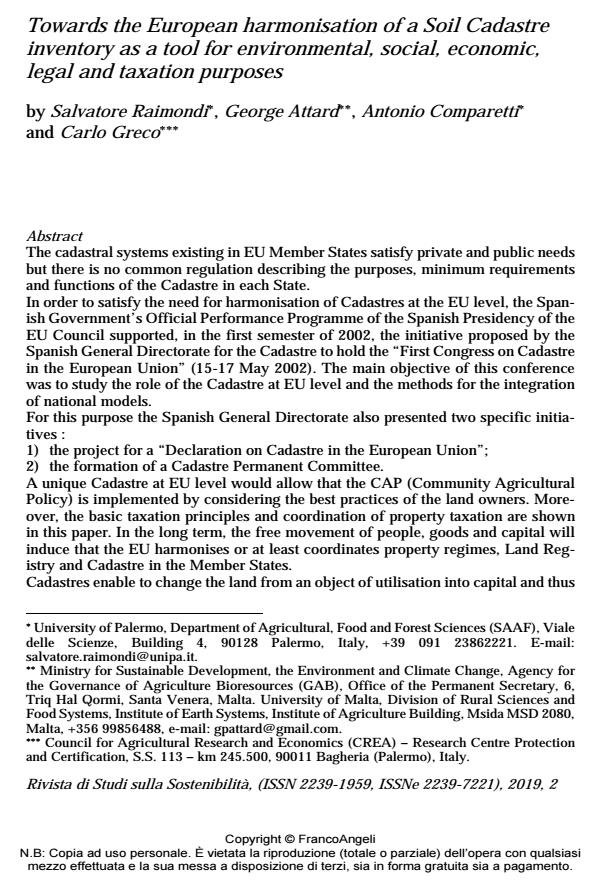Towards the European harmonisation of a Soil Cadastre inventory as a tool for environmental, social, economic, legal and taxation purposes
Journal title RIVISTA DI STUDI SULLA SOSTENIBILITA'
Author/s Salvatore Raimondi, George Attard, Antonio Comparetti, Carlo Greco
Publishing Year 2020 Issue 2019/2 Suppl.
Language English Pages 23 P. 275-297 File size 114 KB
DOI 10.3280/RISS2019-002-S1018
DOI is like a bar code for intellectual property: to have more infomation
click here
Below, you can see the article first page
If you want to buy this article in PDF format, you can do it, following the instructions to buy download credits

FrancoAngeli is member of Publishers International Linking Association, Inc (PILA), a not-for-profit association which run the CrossRef service enabling links to and from online scholarly content.
The cadastral systems existing in EU Member States satisfy private and public needs but there is no common regulation describing the purposes, minimum requirements and functions of the Cadastre in each State. In order to satisfy the need for harmonisation of Cadastres at the EU level, the Spanish Government’s Official Performance Programme of the Spanish Presidency of the EU Council supported, in the first semester of 2002, the initiative proposed by the Spanish General Directorate for the Cadastre to hold the "First Congress on Cadastre in the European Union" (15-17 May 2002). The main objective of this conference was to study the role of the Cadastre at EU level and the methods for the integration of national models. For this purpose the Spanish General Directorate also presented two specific initiatives : 1) the project for a "Declaration on Cadastre in the European Union"; 2) the formation of a Cadastre Permanent Committee. A unique Cadastre at EU level would allow that the CAP (Community Agricultural Policy) is implemented by considering the best practices of the land owners. Moreover, the basic taxation principles and coordination of property taxation are shown in this paper. In the long term, the free movement of people, goods and capital will induce that the EU harmonises or at least coordinates property regimes, Land Registry and Cadastre in the Member States. Cadastres enable to change the land from an object of utilisation into capital and thus economic growth (that is a prerequisite for investments in estate enhancement and/or environmental protection). This is an essential part of LIS (Land Information System) and GIS (Geographic Information System) systems, that provide information crucial to decision making. The new soil cadastral certificate, besides land use and capability, should also take into account the sustainability. The Ground Cadastre should be developed into a multipurpose Soil Cadastre, i.e. an inventory for environmental, social, economic, legal and taxation purposes.
Keywords: Land use, land capability, soil degradation, sustainability, landscape, territorial planning.
- National development strategies in terms of ensuring environmental rights and interests: Comparative approach Anatolii P. Getman, Hanna V. Anisimova, in Journal of the National Academy of Legal Sciences of Ukraine /2021 pp.250
DOI: 10.37635/jnalsu.28(4).2021.250-261 - XV International Scientific Conference “INTERAGROMASH 2022” Kirill Zhichkin, Lyudmila Zhichkina, Oleg Mamaev, Olga Grunina, Alexander Tarakanov, Irada Rustamova, Galina Korneva, pp.2983 (ISBN:978-3-031-21431-8)
Salvatore Raimondi, George Attard, Antonio Comparetti, Carlo Greco, Towards the European harmonisation of a Soil Cadastre inventory as a tool for environmental, social, economic, legal and taxation purposes in "RIVISTA DI STUDI SULLA SOSTENIBILITA'" 2 Suppl./2019, pp 275-297, DOI: 10.3280/RISS2019-002-S1018